Have you heard of the zero waste clothing brand four rabbit? If you haven't, they are pretty cool. Their stuff is even in the Copper Hewit Store. New York-based Arielle Toelke is the one woman show behind four rabbit, and has a deep knowledge of fine art and zero waste design. She wants to change the way people think about eco-fashion by seamlessly blending function and style for lightweight travel.
Her Tsunami Jacket is a perfect example of her brand's mission. The low impact, digitally printed jacket is made of Tyvek. Tyvek is basically a recyclable plastic paper. The textile creates, literally, a paper-thin lightweight garment. And, like all of her styles, the jacket uses zero waste pattern pieces.
WHAT IS ZERO WASTE FASHION?
Zero waste fashion design takes the entire garment lifecycle into account to ensure waste free fashion. And, in the ever-evolving world of sustainable fashion zero waste is a hot trend.
HOW TO CREATE ZERO WASTE DESIGNS
So instead of explaining to you what zero waste fashion design is and ins't, Arielle and I are going to show you how four rabbit makes their zero waste t-shirt.
SOURCING TRIP TO INDIA
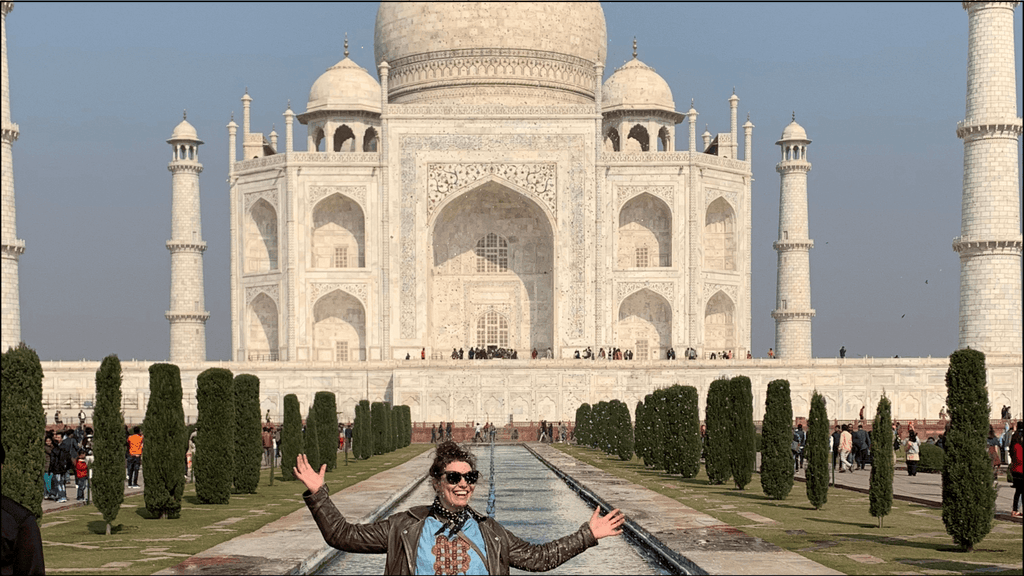
Arielle of four rabbit at the Taj Mahal on virtue + vice's 10 day sustainable fashion tour!
10 days, 4 cities, 1 zero waste shirt!
Arielle joined virtue + vice last January on our 10-day Sustainable Fashion Tour through India. On the trip, everyone had different goals. Some were there to just experience India, some were interested in artisan workshops and learning about India's history of handicrafts, and some, like Arielle, were there to gain contacts for their sustainable fashion brand.
We traveled from Delhi to Agra, to Jaipur, spent a day in Bagru, and then ended our trip in Maheshwar (actually Arielle even came to Goa with me for a week after the "official trip"), and, along the way, she was able to design, develop, and produce a zero waste shirt.
HOW TO DESIGN A ZERO WASTE T-SHIRT
Before you start creating your zero waste fashion brand, you will need to think about your entire supply chain. From the initial design concepts all the way to fabric waste in landfills. This is because zero waste fashion brands must account for every single step to ensure all resources are used, and environmental impact is minimal.
STEP 1: FABRIC SELECTION
So, let's get started with zero waste product design. When designing zero-waste clothing the first step is choosing the right fabric that won't create any clothing waste. There are two ways of going about this fabric waste design challenge.
Available Inventory vs. deadstock fabrics
First, we limited our search to fabric qualities with available yardage, not deadstock. Factories, especially t-shirt factories that run the same fabrics over and over and over, tend to have warehouses full of their fabrics. It is cheaper to produce fabrics in large bulk amounts, and because the fabrics are common (commodity fabrics) eventually they will be used.
Many novice brands, media, and fashion magazines would like to believe that the fabrics inside of these warehouses is all textile waste and companies like four rabbit are saving the fabric from a landfill. But, eventually, someone, like four rabbit will buy it.
Why is available inventory an advantage to deadstock
True deadstock fabric is usually damaged or has some defect that has made the fashion industry not want it. The problem with deadstock is you don't always know what the defect is. It could be something as small as a color variance. In that case, who cares? use it. Or, it could be that the fabric did not past testing and disintegrates in the wash. Using deadstock fabric is a crapshoot.
So, because available inventory, as opposed to true deadstock, gave us access to higher quality and more reliable textiles, that would, in theory, last longer and perform better we chose that route. Environmentally speaking at the end of the day the impact was the same - with both available inventory and deadstock, the fabric was already made and ready to go. Four rabbit did not need to create anything new.
Choosing the right Fibers
Next, we needed to choose what fiber content to use. Again, because Arielle was creating a true zero-waste design, where the fibers end up when the shirt gets thrown away is important. For this first order, the shirts are made out of 100% cotton. Yes, of course, there are other "more sustainable" fiber options out there like hemp or even organic cotton. But, when you are dealing with available fabrics you can't always be picky and need to take what you can get. And, in the spectrum of sustainable design, cotton is a lot more eco-friendly than a synthetic fiber like polyester aka plastic.
SUSTAINABILITY PRO TIP:
Some companies are even starting to use factory scraps to make new textiles. IroIro in Jaipur is one of these companies. Bhaavya's family owns a factory in Jaipur. She takes all of her families waste and does zero waste weaving to create new upcycled textiles. If you are thinking about designing a zero waste collection, they are definitely worth checking out.
STEP 2 - ZERO WASTE PATTERN MAKING
Each zero waste pattern needs to be custom made to the width of the specific fabric chosen. This means before we could get to work on the pattern, first we needed to know how wide the fabric was.
In conventional t-shirt making, often patterns are made first, and then fabrics are chosen. But, in conventional patterns, there is also a lot of space between each pattern piece, which creates a lot of waste. A zero waste pattern ensures that when the cutting room starts to cut the garment that absolutely nothing will be wasted.
This is a serious task for designers. A designer, of course, wants their garment to fit perfectly when they work on clothing pattern design, But, zero waste adds a new set of rules and constraints to traditional design. They now need to create a garment that looks good and wastes absolutely nothing. The key to a quality product is not to compromise the fit of the garments to accommodate wanting to use all the fabric when designing clothing patterns.
SUSTAINABILITY PRO TIP:
Creating a zero waste pattern while makng compromises for fit and ensuring nothing goes to waste is a fine line to walk, and takes a level of expertise to accomplish. If you are finding your pattern still has extra fabric, consider making something to give away for free. Like a scrunchie. With the extra fabric in her pattern four rabbit makes a storage pouch for her tsunami jacket.
STEP 3 - trims, labels and tags
Let's be real. Hang tags have no purpose but to be removed and thrown away. If you need to use a hang tag (some retail stores require them) I would recommend using one made out of recycled paper. Or, even better cotton that has been collected from factory cutting rooms floors and been downcycled into paper. There are also tags on the market that have seeds and can be planted to grow flowers.
But, if you can I would skip the hangtags all together.
Cloth labels can be made to order. But, I would skip them too. Instead, invest in a wooden block to stamp the logo and care instructions on. The block will last forever.
STEP 4 - who made my clothes?
We have the fabric, we have the pattern. Now, it's time to make the zero waste shirt a reality. Even though labor practices are technically not part of zero waste, they are still important.
So, when choosing a factory, make sure to choose a good one. One that cares about their employees and works transparently. If you can (I know not every brand can afford this starting out) try and visit yourself.
Step 5 - decorate it
Block Printing
Arielle chose to block print, and then dye her shirts. Block printing is a great alternative to conventional print methods, and you can learn more about the positive environmental impacts here.
In block printing, a wooden block is carved with a pattern. The block then acts as a stamp to print the fabric. Before Arielle came on the trip we had the print house in Bagru develop her snake design and four rabbit design into blocks. This way when she got there they were ready for her to use. Generally, blocks take about 1 month to develop.
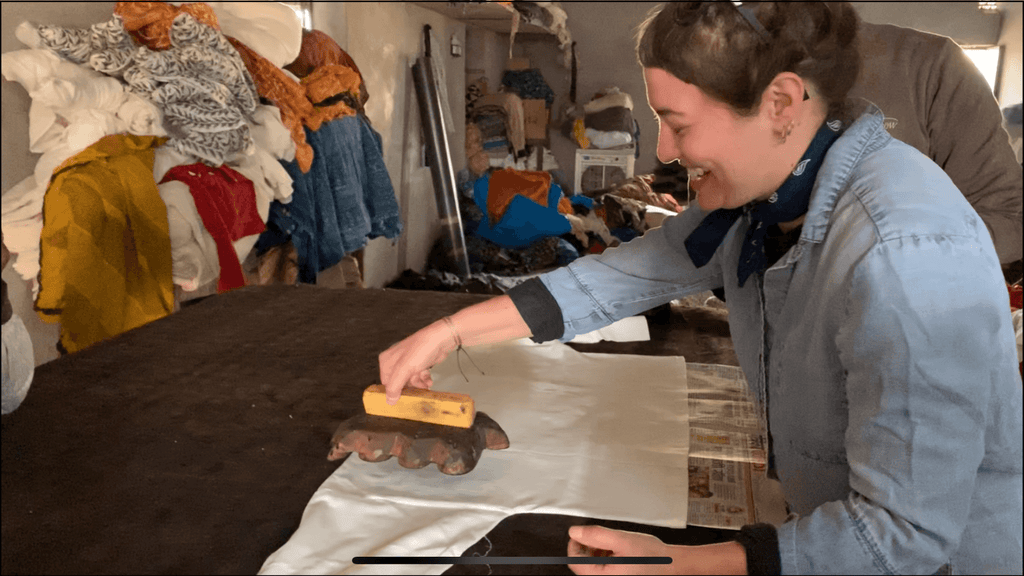
Arielle getting ready for the big moment of truth - the first block print EVER!
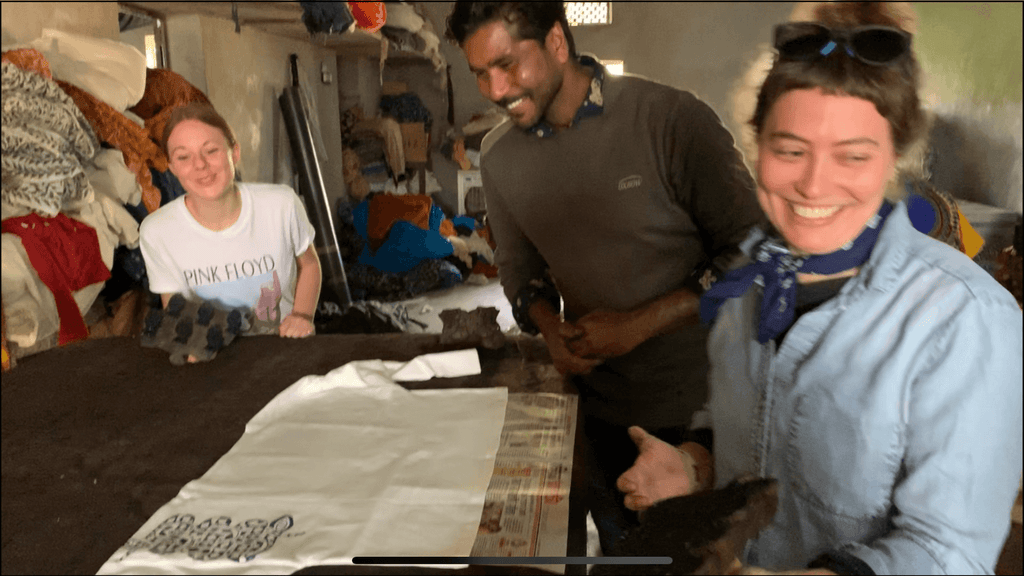
Everyone was so excited for Arielle!
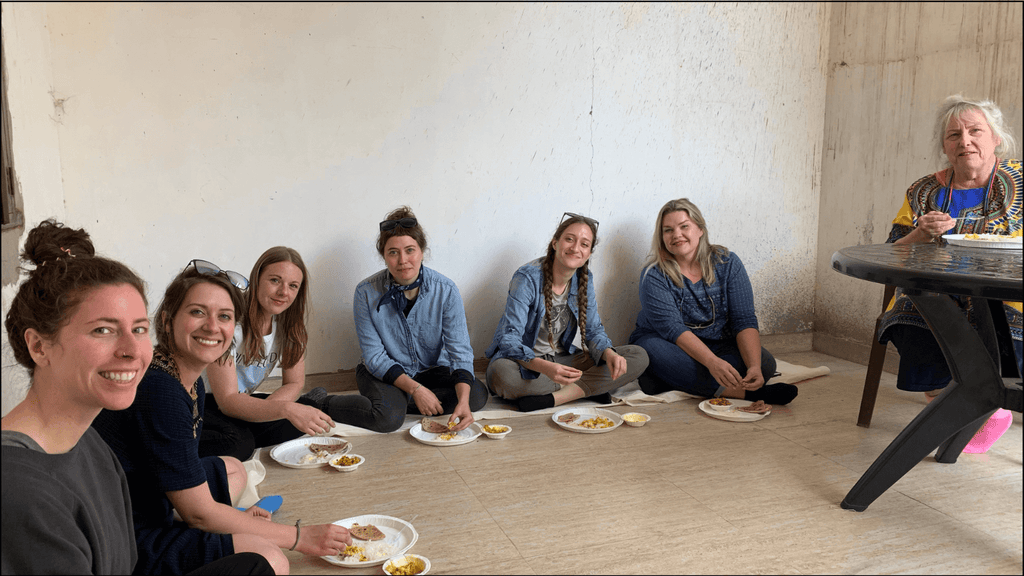
And, a quick lunch break
dye
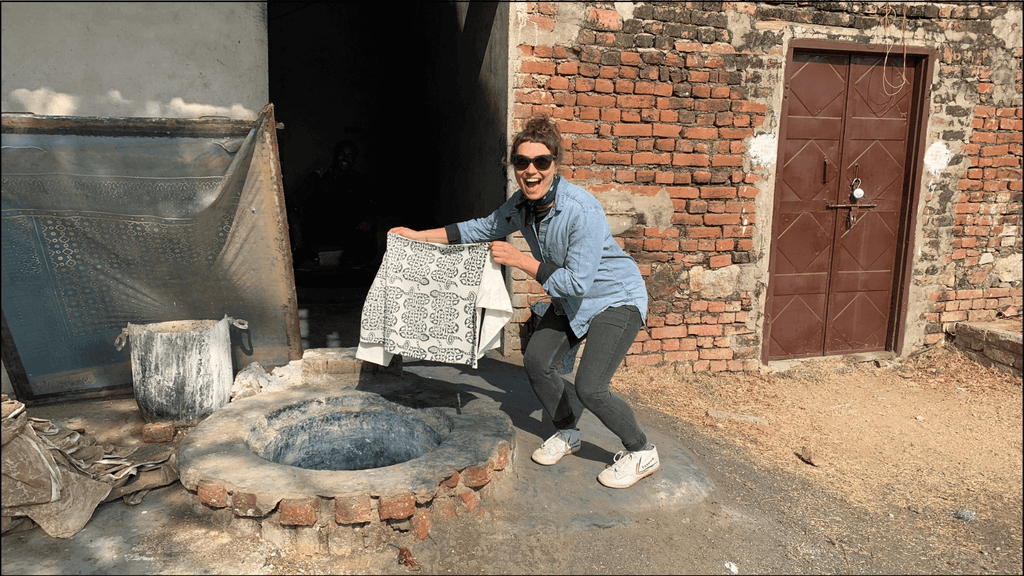
Block printing is done, now time for some color!

My good friend Deepak from Block Print House dip dying a four rabbit shirt

tah-dah!
Arielle did a different dye process on each of her two shirts. The first shirt was dipped in an underground indigo well that has been around for about 100 years!
The second shirt she chose to dye in onion peels. While we were visiting weavers in Maheshwar they dyers on the roof were prepping an onion dye for yarns to be woven. TBH, at first, I thought they were cooking soup. It smelled pretty good. Arielle decided on the spot to toss one of her 0 waste designs in.

this is what natural onion dye looks like

another shirt ready for dyeing, this one with the four rabbit logo
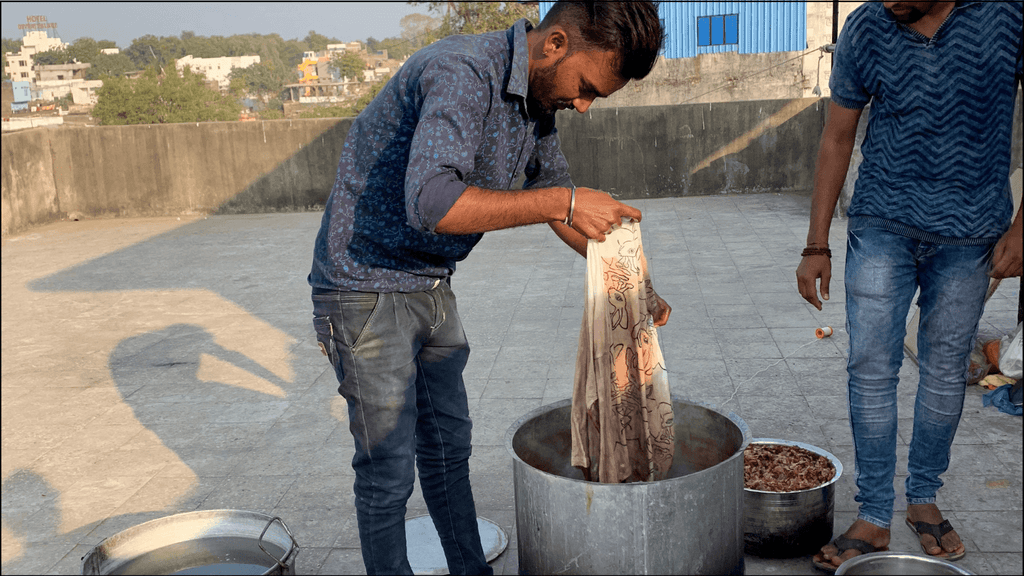
first dip in the dye pot. natural dyes take a lot of time to build color.
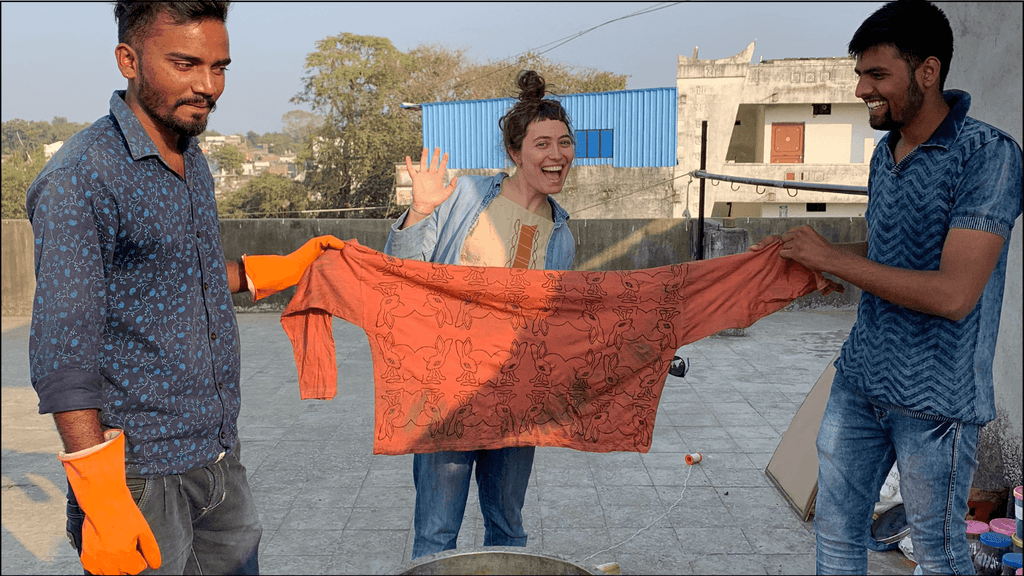
How great is this color?
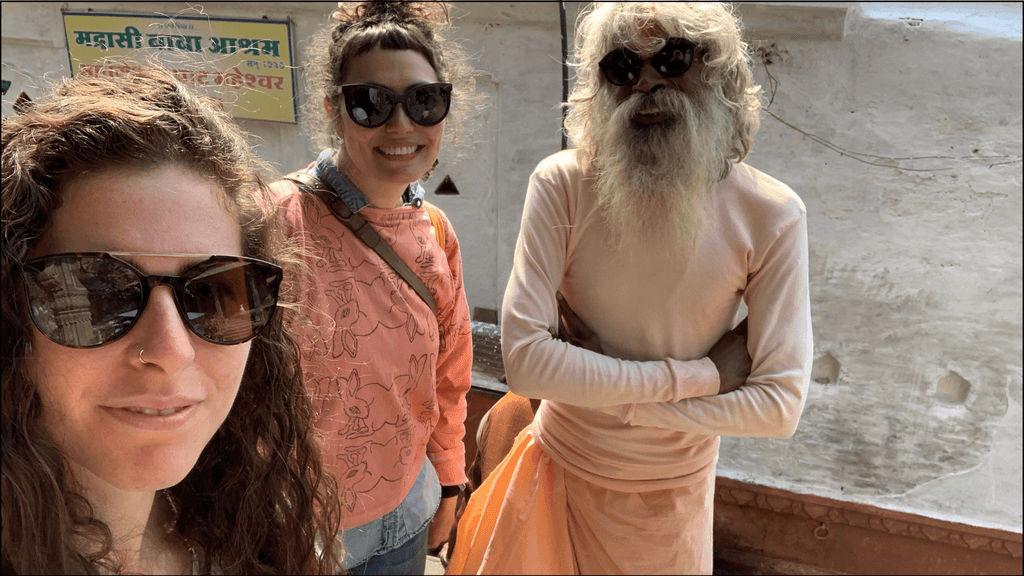
and... the finished product
Now, you can't always get as lucky as Arielle and be able to use an available dye vat. So, I would recommend using dyes made from food scraps. Old foods like onions, avocado pits, and berries can make for great dyes. Did you know that even rusty nails can create fabric dye?!
SUSTAINABILITY PRO TIP:
When natural plant dying the fabric used should always be natural too!
If you are interested in more four rabbit styles or would like more information about her designs, check out their site.
helpful resources zero waste resources
get inspired by other designers zero waste fashion
Check out the zero waste brands like Holly McQuillan, Zero Waste Daniel, Madeleine Vionnet, or Timo Rissanen (who has a Ph.D. in zero waste design and is a professor at Parsons) for a little zero fashion waste inspo.
learn from the best
Julian Roberts teaches the math and science behind zero waste pattern cutting.
get involved
Stop by a zero waste nyc meetup. Or, swing by the NYC Center For Architecture to check out their recent exhibitions and course offerings on zero waste. If you don't live in NYC, the AIANY zero waste design guidelines are available online with other resources.
volunteer
FABSCRAP turns NYC waste from the fashion industry into supplies for emerging designers. It's a great way to help out and meet new friends. And, because the brands they collect from are trying to waste zero clothing you will sometimes find some great designer samples that are being donated and are up for grabs for volunteers!

Leave a comment